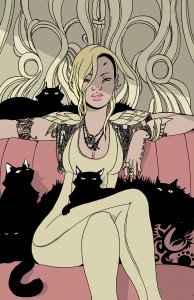 A few weeks ago, we were talking about comics for kids; this week, let’s talk about another underserved class of readers: girls and women. There’ve always been exceptions to the comics-are-for-guys meme — the Chris Claremont X-Men of the ’70s and ’80s, New Teen Titans in the ’80s, Sandman and a lot of Vertigo titles in the ’90s, and big chunks of the manga boom in the ’00s — but in the last two years we’ve seen both a new commitment by the big comics companies to attract a more diverse audience, and an explosion of female creators, both writers and artists; together, they’ve begun opening up the stuffy boys’ comics clubhouse, and letting in some welcome fresh air. The eight leadoff titles here cover a lot of ground, but have some things in common: they’re mostly by younger creators; often have art that’s more cartoony and design-oriented than older styles (and often influenced either by manga or by TV animation gurus like John Kricfalusi, Genndy Tartakovsky and Pendleton Ward); embrace diversity; and feature smart, independent, problem-solving lead characters who use digital connections and social media as easily as they breathe. The books here aren’t just for girls and women, mind you, but they’re a lot friendlier to them than most of the testosterone-fueled super-hero stories bought by the 25-50-year-old fanboys who’ve traditionally made up the bulk of the American comics market — and if you’re looking for holiday comics gifts that would work for all ages and genders, they more than fit the bill.
A few weeks ago, we were talking about comics for kids; this week, let’s talk about another underserved class of readers: girls and women. There’ve always been exceptions to the comics-are-for-guys meme — the Chris Claremont X-Men of the ’70s and ’80s, New Teen Titans in the ’80s, Sandman and a lot of Vertigo titles in the ’90s, and big chunks of the manga boom in the ’00s — but in the last two years we’ve seen both a new commitment by the big comics companies to attract a more diverse audience, and an explosion of female creators, both writers and artists; together, they’ve begun opening up the stuffy boys’ comics clubhouse, and letting in some welcome fresh air. The eight leadoff titles here cover a lot of ground, but have some things in common: they’re mostly by younger creators; often have art that’s more cartoony and design-oriented than older styles (and often influenced either by manga or by TV animation gurus like John Kricfalusi, Genndy Tartakovsky and Pendleton Ward); embrace diversity; and feature smart, independent, problem-solving lead characters who use digital connections and social media as easily as they breathe. The books here aren’t just for girls and women, mind you, but they’re a lot friendlier to them than most of the testosterone-fueled super-hero stories bought by the 25-50-year-old fanboys who’ve traditionally made up the bulk of the American comics market — and if you’re looking for holiday comics gifts that would work for all ages and genders, they more than fit the bill.
 Unbeatable Squirrel Girl #3 — Writer: Ryan North; Art: Erica Henderson; Colors: Rico Renzi
Unbeatable Squirrel Girl #3 — Writer: Ryan North; Art: Erica Henderson; Colors: Rico Renzi
Batgirl #46 — Writers: Cameron Stewart and Brenden Fletcher; Art: Babs Tarr; Colors: Serge Lapointe
Ms. Marvel #2 — Writer: G. Willow Wilson; Art: Takeshi Miyazawa; Colors: Ian Herring
These first three books are the trailblazers — they’ve 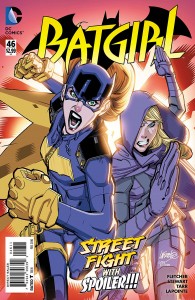 all been around for a year or two, and, while they don’t set the monthly pamphlet charts on fire, they do enormously well in the trade and digital versions favored by younger readers. The ages of their protagonists vary — Ms. Marvel’s still learning to navigate high school, while Squirrel Girl is starting college and Batgirl is close to finishing it — but they’re all bright, funny, decent young adults who’ve lucked into some power (or, in Batgirl’s case, a knack for athletic vigilantism), and can’t help but use it to try to make the world a better place. Squirrel Girl‘s got the highest energy
all been around for a year or two, and, while they don’t set the monthly pamphlet charts on fire, they do enormously well in the trade and digital versions favored by younger readers. The ages of their protagonists vary — Ms. Marvel’s still learning to navigate high school, while Squirrel Girl is starting college and Batgirl is close to finishing it — but they’re all bright, funny, decent young adults who’ve lucked into some power (or, in Batgirl’s case, a knack for athletic vigilantism), and can’t help but use it to try to make the world a better place. Squirrel Girl‘s got the highest energy  level and the most unique approach (the North/Henderson team really play to each other’s strengths, and their combined work is like no one else’s), while Batgirl and Ms. Marvel have more-traditional, very-solid storytelling accentuated by sleek, manga-influenced art; Babs Tarr’s, especially, makes Batgirl worth it, while in Ms. Marvel Miyazawa nails the innocence and wide-eyed sense of fun of the title character, complementing Wilson’s combination of high-school angst, super-heroics and lesson-teaching that makes it read like one of Stan Lee’s early Spider-Man comics. All three books have been successes, and so encouraged Marvel and DC to offer more books like them. For example…
level and the most unique approach (the North/Henderson team really play to each other’s strengths, and their combined work is like no one else’s), while Batgirl and Ms. Marvel have more-traditional, very-solid storytelling accentuated by sleek, manga-influenced art; Babs Tarr’s, especially, makes Batgirl worth it, while in Ms. Marvel Miyazawa nails the innocence and wide-eyed sense of fun of the title character, complementing Wilson’s combination of high-school angst, super-heroics and lesson-teaching that makes it read like one of Stan Lee’s early Spider-Man comics. All three books have been successes, and so encouraged Marvel and DC to offer more books like them. For example…
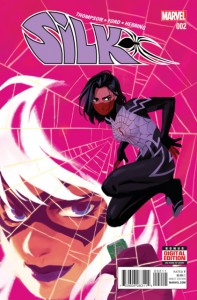 Silk #2 — Writer: Robbie Thompson; Art: Tana Ford; Colors: Ian Herring
Silk #2 — Writer: Robbie Thompson; Art: Tana Ford; Colors: Ian Herring
Starbrand and Nightmask #1 — Writer: Greg Weisman; Art: Domo Stanton; Colors: Jordan Boyd
Super Zero #1 — Writers: Amanda Connor and Jimmy Palmiotti; Art: Rafael de Latorre; Colors: Marcelo Maiolo
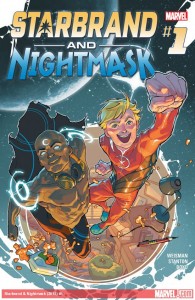 Jem and the Holograms Holiday Special #1 — Writer: Kelly Thompson; Art: Amy Mebberson; Colors: M. Victoria Robado
Jem and the Holograms Holiday Special #1 — Writer: Kelly Thompson; Art: Amy Mebberson; Colors: M. Victoria Robado
Lumberjanes #21 — Writers: Shannon Walters and Kat Leyh; Art: Carey Pietsch; Colors: Maarta Laiho
Silk is to the Spider-Man universe like Batgirl is to the Batman one: a twenty-something heroine with  similar powers to the original franchise version, but drawn in a more exaggerated style (although Ford’s influences are closer to American indy books than to Japan), and with a slightly-lighter touch. There’s a lot of connection to the Spidey cast here — Silk works as a criminal for the Black Cat, fights the Goblin Nation knock-offs from Superior Spider-Man, and actually is a double agent reporting to S.H.I.E.L.D. — and that will probably draw in enough fans to make it successful. Starbrand and Nightmask is the only comic in this bunch without a female lead, but its manga style,
similar powers to the original franchise version, but drawn in a more exaggerated style (although Ford’s influences are closer to American indy books than to Japan), and with a slightly-lighter touch. There’s a lot of connection to the Spidey cast here — Silk works as a criminal for the Black Cat, fights the Goblin Nation knock-offs from Superior Spider-Man, and actually is a double agent reporting to S.H.I.E.L.D. — and that will probably draw in enough fans to make it successful. Starbrand and Nightmask is the only comic in this bunch without a female lead, but its manga style, 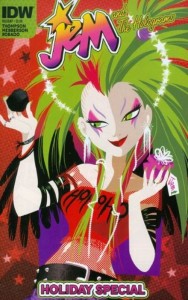 its college-freshmen title characters (they go to Empire University, and cross paths with Squirrel Girl in this first issue), its humor and its young-adult sensibilities all make it fit in. Super Zero is specifically about a comics fangirl, a high-schooler who wants desperately to get powers but (apparently) lives in the “real” world and can’t. Its attraction is the Connor/Palmiotti writing team, who’ve done so well on Harley Quinn and here demonstrate a good mix of sly sendups of the comics field and well-drawn, quirky-but-relatable characters. Jem and the Holograms has been a comics success even as the movie version of the same property failed, mostly on the strength of its sharply-
its college-freshmen title characters (they go to Empire University, and cross paths with Squirrel Girl in this first issue), its humor and its young-adult sensibilities all make it fit in. Super Zero is specifically about a comics fangirl, a high-schooler who wants desperately to get powers but (apparently) lives in the “real” world and can’t. Its attraction is the Connor/Palmiotti writing team, who’ve done so well on Harley Quinn and here demonstrate a good mix of sly sendups of the comics field and well-drawn, quirky-but-relatable characters. Jem and the Holograms has been a comics success even as the movie version of the same property failed, mostly on the strength of its sharply- delineated title crew and inclusive girl-power themes; this issue offers a stand-along Christmas story that brings the Holograms and their battle-of-the-bands rivals together a little bit, and makes everyone a little more human. Lumberjanes could have been in the top group, because it’s been around longer than any of the others — although as an indy non-super-hero book, and one that owes more to TV animation than comics styles, it doesn’t quite match them. However, its adventurous enchanted-forest plots, easy inclusiveness, and gentle emphasis on teamwork, friendship and problem-solving make it a good bookend to them, and just the right way to round out this list.
delineated title crew and inclusive girl-power themes; this issue offers a stand-along Christmas story that brings the Holograms and their battle-of-the-bands rivals together a little bit, and makes everyone a little more human. Lumberjanes could have been in the top group, because it’s been around longer than any of the others — although as an indy non-super-hero book, and one that owes more to TV animation than comics styles, it doesn’t quite match them. However, its adventurous enchanted-forest plots, easy inclusiveness, and gentle emphasis on teamwork, friendship and problem-solving make it a good bookend to them, and just the right way to round out this list.
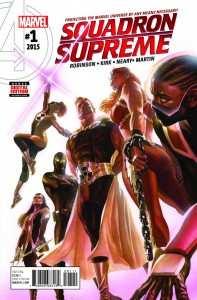 Squadron Supreme #1 — Writer: James Robinson; Pencils: Leonard Kirk; Inks: Paul Neary; Colors: Frank Martin
Squadron Supreme #1 — Writer: James Robinson; Pencils: Leonard Kirk; Inks: Paul Neary; Colors: Frank Martin
Weirdworld #1 — Writer: Sam Humphries; Art: Mike Del Mundo; Colors: Mike Del Mundo with Marco D’Alfonso
Marvel’s Captain America: Civil War Prelude #1 (of 4) — Writer: Will Corona Pilgrim; Art: Szymon Kudranski; Colors: Guru-eFX
Amazing Spider-Man #1.1 — Writer: Jose Moilina; Art: Simone Bianchi; Colors: Israel Silva
The week’s Marvel debuts: Squadron Supreme is exactly the kind of “testosterone- fueled super-hero story” I was mentioning up above, but there’s nothing wrong with that (it’s just nice to see some other types of comics out there too…), and for what it is it’s pretty good: the team isn’t the same set of bad guys as in the Secret Wars mini-series, but instead a collection of multiverse survivors (so, Nighthawk is the Straczynski version from his Supreme Power, while their speedster is Blur from the Marvel ’80s New Universe, Hyperion is a hero, Dr. Spectrum is a woman, etc.), who see their job as protecting the planet from threats — with extreme prejudice, if necessary. Their first target is Prince Namor, the Sub-Mariner, because he destroyed Dr. Spectrum’s universe back when he was in the Cabal and blah blah Hickman encroachments whatever, and let’s just say they demonstrate a cold-blooded directness and efficiency in going about it (although for anyone who
fueled super-hero story” I was mentioning up above, but there’s nothing wrong with that (it’s just nice to see some other types of comics out there too…), and for what it is it’s pretty good: the team isn’t the same set of bad guys as in the Secret Wars mini-series, but instead a collection of multiverse survivors (so, Nighthawk is the Straczynski version from his Supreme Power, while their speedster is Blur from the Marvel ’80s New Universe, Hyperion is a hero, Dr. Spectrum is a woman, etc.), who see their job as protecting the planet from threats — with extreme prejudice, if necessary. Their first target is Prince Namor, the Sub-Mariner, because he destroyed Dr. Spectrum’s universe back when he was in the Cabal and blah blah Hickman encroachments whatever, and let’s just say they demonstrate a cold-blooded directness and efficiency in going about it (although for anyone who 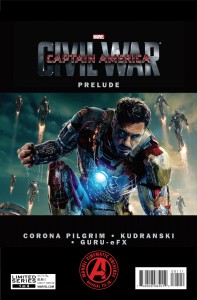 thinks the events in this issue are permanent, I have some former cemetery plots for Jean Gray and Bucky Barnes I’d be happy to sell you…). It’s all solid, continuity-rich work, although whether this version of the team will do any better than Marvel’s other attempts to market them remains to be seen. Weirdworld is a continuation of the Secret Wars mini, although it’s got a new viewpoint character (a high-school senior whose plane crashed there) and a new ally for her, even as the inhabitants we already know get name-checked too; Del Mundo has the right kind of misty, gonzo, painted-barbarian style for the proceedings, and Humphries makes it unexpectedly interesting enough to check in again next month. The Captain America Civil War Prelude occurs in the Marvel Movie universe, and, obviously, is meant as
thinks the events in this issue are permanent, I have some former cemetery plots for Jean Gray and Bucky Barnes I’d be happy to sell you…). It’s all solid, continuity-rich work, although whether this version of the team will do any better than Marvel’s other attempts to market them remains to be seen. Weirdworld is a continuation of the Secret Wars mini, although it’s got a new viewpoint character (a high-school senior whose plane crashed there) and a new ally for her, even as the inhabitants we already know get name-checked too; Del Mundo has the right kind of misty, gonzo, painted-barbarian style for the proceedings, and Humphries makes it unexpectedly interesting enough to check in again next month. The Captain America Civil War Prelude occurs in the Marvel Movie universe, and, obviously, is meant as 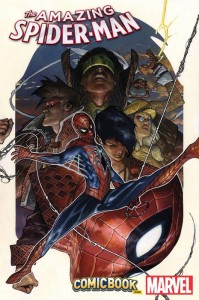 set-up for the film coming in mid-2016; this first issue is actually all about Iron Man, with Steve Rogers presumably showing up next time, and if you like the films you should enjoy it. Amazing Spider-Man 1.1 is actually a Spidey mini-series involving voodoo in New York City, but Marvel must figure if they decimal-point it they’ll attract more readers. It’s fine, although not as good as the main title; it introduces a group called the Santerians, who appear to be both good guys and practitioners of that religion (one looks forward to other new super-groups called “The Catholicians,” “The Hinduians” and “The Jewians”), and it’s all OK-but-generic superhero entertainment.
set-up for the film coming in mid-2016; this first issue is actually all about Iron Man, with Steve Rogers presumably showing up next time, and if you like the films you should enjoy it. Amazing Spider-Man 1.1 is actually a Spidey mini-series involving voodoo in New York City, but Marvel must figure if they decimal-point it they’ll attract more readers. It’s fine, although not as good as the main title; it introduces a group called the Santerians, who appear to be both good guys and practitioners of that religion (one looks forward to other new super-groups called “The Catholicians,” “The Hinduians” and “The Jewians”), and it’s all OK-but-generic superhero entertainment.
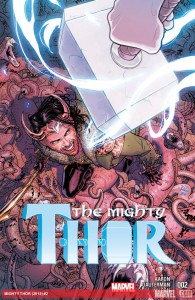 Mighty Thor #2 — Writer: Jason Aaron; Art: Russell Dauterman; Colors: Matthew Wilson
Mighty Thor #2 — Writer: Jason Aaron; Art: Russell Dauterman; Colors: Matthew Wilson
All-New X-Men #2 — Writer: Dennis Hopeless; Pencils: Mark Bagley; Inks: Anmdrew Hennessy; Colors: Nolan Woodard
Web-Warriors #2 — Writer: Mike Costa; Pencils: David Baldeon; Inks: Scott Hanna and Livesay; Colors: Jason Keith
 Illuminati #2 — Writer: Joshua Williamson; Art: Shawn Crystal; Colors: John Rauch
Illuminati #2 — Writer: Joshua Williamson; Art: Shawn Crystal; Colors: John Rauch
All-New Inhumans #2 — Writers: James Asmus and Charles Soule; Art: Stefano Caselli; Colors: Andres Mossa
Uncanny Inhumans #3 — Writer: Charles Soule; Pencils: Steve McNiven; Inks: Jay Leisten; Colors: 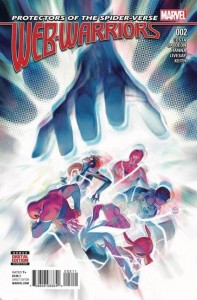 Sunny Cho and Java Tartaglia
Sunny Cho and Java Tartaglia
Deadpool #3.1 (Tres Punto Uno) — Writers: Brian Posehn and Gerry Duggan; Art: Scott Koblish; Colors: Nick Filardi
Ultimate End #5 — Writer: Brian Michael Bendis; Pencils: Mark Bagley; Inks: Scott Hanna; Colors: Justin Ponsor
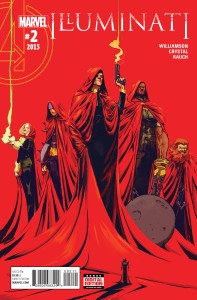 Some other Marvels, mostly sophomore efforts. Mighty Thor is the best, and its use of Jane Foster as an appealingly-heroic new Thunder God might have kicked it to the female-friendly list up above, although its Asgardian-style violence and deep dive into Marvel continuity make it closer to a mainstream book. It has Loki back as, maybe, a bad guy, which would be too bad — Kid Loki and the version from his last series were both intriguing, complicated characters, and it would be disappointing to see him reduced back to a traditional villain. Still, Aaron hasn’t made a wrong move with this
Some other Marvels, mostly sophomore efforts. Mighty Thor is the best, and its use of Jane Foster as an appealingly-heroic new Thunder God might have kicked it to the female-friendly list up above, although its Asgardian-style violence and deep dive into Marvel continuity make it closer to a mainstream book. It has Loki back as, maybe, a bad guy, which would be too bad — Kid Loki and the version from his last series were both intriguing, complicated characters, and it would be disappointing to see him reduced back to a traditional villain. Still, Aaron hasn’t made a wrong move with this 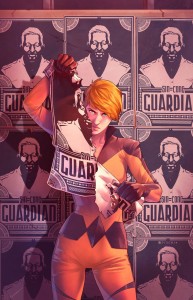 title yet, so it’s only fair to give him some time, and wait to see just whom the Trickster is actually fooling here. All-New X-Men has Kid Cyclops facing off against a gang of super-powered revolutionaries who think they’re paying tribute to his older incarnation, and then the rest of the new team getting involved too; its best selling point is the nice-looking Bagley art. Web-Warriors continues the adventures of a group of alternate-universe Spider-Men (Gwen Stacy, the cartoon pig, the one from India, the Captain Britain one, etc.) who are trying to keep the multiverse safe, but now they’re fighting a similar group of multiversal Electros; that’s a clever enough
title yet, so it’s only fair to give him some time, and wait to see just whom the Trickster is actually fooling here. All-New X-Men has Kid Cyclops facing off against a gang of super-powered revolutionaries who think they’re paying tribute to his older incarnation, and then the rest of the new team getting involved too; its best selling point is the nice-looking Bagley art. Web-Warriors continues the adventures of a group of alternate-universe Spider-Men (Gwen Stacy, the cartoon pig, the one from India, the Captain Britain one, etc.) who are trying to keep the multiverse safe, but now they’re fighting a similar group of multiversal Electros; that’s a clever enough 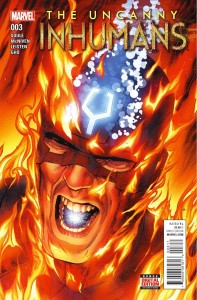 idea to keep things percolating along nicely. Illuminati is The Hood putting together a group of criminals for his own purposes, while a trying-to-reform Titania gets caught in the middle; the best thing about it is Shawn Crystal’s sketchy, slightly-off-center art, which reminds me a little of Kevin O’Neill. Two Inhumans books in the same week are at least one too many; it’s well-known that Marvel’s trying to make them the new X-Men, but there’s yet to be a sign that anyone in the audience cares. All-New Inhumans is more episodic, with Crystal and a big floaty ship going around the world trying to help countries deal with the effects of the terrigen mists; in this issue, they visit “Sin-Cong,”
idea to keep things percolating along nicely. Illuminati is The Hood putting together a group of criminals for his own purposes, while a trying-to-reform Titania gets caught in the middle; the best thing about it is Shawn Crystal’s sketchy, slightly-off-center art, which reminds me a little of Kevin O’Neill. Two Inhumans books in the same week are at least one too many; it’s well-known that Marvel’s trying to make them the new X-Men, but there’s yet to be a sign that anyone in the audience cares. All-New Inhumans is more episodic, with Crystal and a big floaty ship going around the world trying to help countries deal with the effects of the terrigen mists; in this issue, they visit “Sin-Cong,” 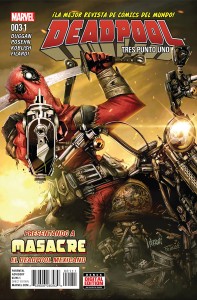 a thinly-veiled North Korea-type dictatorship, with fairly predictable results. Uncanny Inhumans is going for longer stories, with Black Bolt and Medusa searching for, and facing off against, their lost son Ahura, who’s been raised by Kang the Conqueror and is now old, powerful and crazy; they’re joined by Hank McCoy and Johnny Storm, among others. Deadpool 3.1 plays off the fact that, in Mexico, the character is called “Massacre” — so, this issue’s about a “Mexican Deadpool” by that name, and it’s entirely in Spanish (that squishy sound you heard was Donald Trump’s head exploding…). Duggan and Posehn have done a good job making the story followable even if you don’t know the language, and are helped by
a thinly-veiled North Korea-type dictatorship, with fairly predictable results. Uncanny Inhumans is going for longer stories, with Black Bolt and Medusa searching for, and facing off against, their lost son Ahura, who’s been raised by Kang the Conqueror and is now old, powerful and crazy; they’re joined by Hank McCoy and Johnny Storm, among others. Deadpool 3.1 plays off the fact that, in Mexico, the character is called “Massacre” — so, this issue’s about a “Mexican Deadpool” by that name, and it’s entirely in Spanish (that squishy sound you heard was Donald Trump’s head exploding…). Duggan and Posehn have done a good job making the story followable even if you don’t know the language, and are helped by 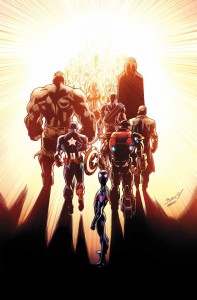 Scott Koblish’s clear art; it’s a successful execution of an interesting conceit. Finally, Ultimate End #5 is, I believe (and pray…) the last of the Secret Wars tie-ins, with the jumbled-together, multiple-version heroes of New York City getting the 411 on what’s actually going on in Battleworld, and leaving to go have it out with Doom. No, nothing gets resolved until Secret Wars #9 next month, but it does give Bendis and Bagley a chance to say goodbye to the universe they helped to birth fifteen years ago — except for at least one character whose fate we see in a four-page coda, which will lead into a new comic next month (you can probably all guess who that is, although I won’t spoil it here…).
Scott Koblish’s clear art; it’s a successful execution of an interesting conceit. Finally, Ultimate End #5 is, I believe (and pray…) the last of the Secret Wars tie-ins, with the jumbled-together, multiple-version heroes of New York City getting the 411 on what’s actually going on in Battleworld, and leaving to go have it out with Doom. No, nothing gets resolved until Secret Wars #9 next month, but it does give Bendis and Bagley a chance to say goodbye to the universe they helped to birth fifteen years ago — except for at least one character whose fate we see in a four-page coda, which will lead into a new comic next month (you can probably all guess who that is, although I won’t spoil it here…).
 Batman ’66 #30 — Writer: Lee Allred; Art/Colors: Michael and Laura Allred
Batman ’66 #30 — Writer: Lee Allred; Art/Colors: Michael and Laura Allred
Batman: Europa #2 (of 4) — Writers: Matteo Casalli and Brian Azzarello; Art/Colors: Giuseppe Camuncoli
We Are Robin #7 — Writer: Lee Bermejo; Art: Carmine Di Giandomenico; Colors: Mat Lopes
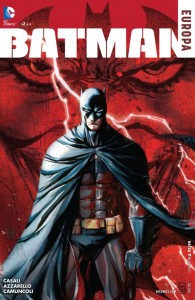 Superman: American Alien #2 (of 7) — Writer: Max Landis; Art/Colors: Tommy Lee Edwards
Superman: American Alien #2 (of 7) — Writer: Max Landis; Art/Colors: Tommy Lee Edwards
Justice League #46 — Writer: Geoff Johns; Art/Colors: Francis Manapul
A quintet of DC books, all Batman or Superman-related: the most fun is Batman ’66, whose final issue 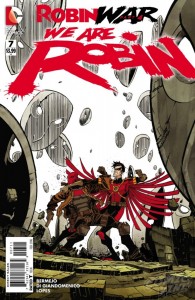 is an Allred family affair: entirely drawn by the great Michael, colored by his wife Laura and written by brother Lee. Pretty much every villain from the TV show is there, looking just as they should (The Joker like Cesar Romeo — down to his mustache showing beneath the white face paint — The Riddler like Frank Gorshin, etc.), and if you were ever a fan of that high-camp classic, then you’ll need this comic. Batman: Europa continues its Batman/Joker team-up (both have been infected by a slow-acting disease, and they have to cooperate in a race around Europe to track down the
is an Allred family affair: entirely drawn by the great Michael, colored by his wife Laura and written by brother Lee. Pretty much every villain from the TV show is there, looking just as they should (The Joker like Cesar Romeo — down to his mustache showing beneath the white face paint — The Riddler like Frank Gorshin, etc.), and if you were ever a fan of that high-camp classic, then you’ll need this comic. Batman: Europa continues its Batman/Joker team-up (both have been infected by a slow-acting disease, and they have to cooperate in a race around Europe to track down the 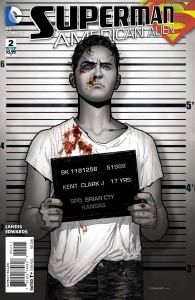 cure), and is a nice-enough package, although it’s lacking the Jim Lee pencils that made the first issue stand out. We Are Robin is the fourth chapter of the “Robin War” crossover event, and features the less-seasoned street vigilantes that are this comic’s heroes watching some nice teamwork from the pros: Red Robin, Jason Todd and Damian Wayne (it’s only got one more chapter, too, in next week’s Robin, Son of Batman, demonstrating that it knows the value of understatement). On the Superman side, there’s the adolescent-Kent mini-series American Alien, kind of a mashup of Smallville and the regular DC universe version of the story; it’s always fun watching the teen
cure), and is a nice-enough package, although it’s lacking the Jim Lee pencils that made the first issue stand out. We Are Robin is the fourth chapter of the “Robin War” crossover event, and features the less-seasoned street vigilantes that are this comic’s heroes watching some nice teamwork from the pros: Red Robin, Jason Todd and Damian Wayne (it’s only got one more chapter, too, in next week’s Robin, Son of Batman, demonstrating that it knows the value of understatement). On the Superman side, there’s the adolescent-Kent mini-series American Alien, kind of a mashup of Smallville and the regular DC universe version of the story; it’s always fun watching the teen  Clark discovering, and coming into, his powers. Finally, Justice League comes back after a month’s worth of “Darkseid War” one-shots; it’s more set-up and conclusion of the story’s second act than anything else (it looks like this will be a total of nine issues, indicating that Johns could take a lesson from the “Robin War” creators about overstaying one’s welcome) but is OK unless you’re looking for closure. If you get the chance, scoop up the alternate cover; DC’s theme this month is “Looney Tunes,” and seeing the various Warner Bros. animated characters cover-featured as the JLA is worth the book’s $3.99 price all by itself (clicking on the cover to the left should reveal a larger version).
Clark discovering, and coming into, his powers. Finally, Justice League comes back after a month’s worth of “Darkseid War” one-shots; it’s more set-up and conclusion of the story’s second act than anything else (it looks like this will be a total of nine issues, indicating that Johns could take a lesson from the “Robin War” creators about overstaying one’s welcome) but is OK unless you’re looking for closure. If you get the chance, scoop up the alternate cover; DC’s theme this month is “Looney Tunes,” and seeing the various Warner Bros. animated characters cover-featured as the JLA is worth the book’s $3.99 price all by itself (clicking on the cover to the left should reveal a larger version).
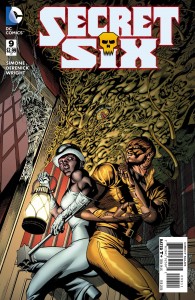 Secret Six #9 — Writer: Gail Simone; Art: Tom Derenick; Colors: Jason Wright
Secret Six #9 — Writer: Gail Simone; Art: Tom Derenick; Colors: Jason Wright
Clean Room #3 — Writer: Gail Simone; Art: Jon Davis Hunt; Colors: Quinton Winter
Lucifer #1 — Writer: Holly Black; Art: Lee Garbett; Colors: Antonio Fabela
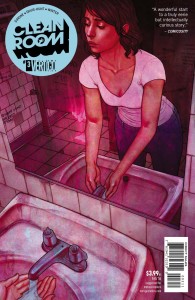 A few more DC books; two are under their Vertigo imprint, while Secret Six, which shares writer Gail Simone with Clean Room, has a dark enough take on the DC universe, with its dysfunctional villains, its often-but-not-always-cynical worldview, and, in this issue, its Lovecraftian elder-gods storyline, to belong here too. Clean Room is even more horrific, about a Scientology-like cult whose deprogramming methods involve deep.
A few more DC books; two are under their Vertigo imprint, while Secret Six, which shares writer Gail Simone with Clean Room, has a dark enough take on the DC universe, with its dysfunctional villains, its often-but-not-always-cynical worldview, and, in this issue, its Lovecraftian elder-gods storyline, to belong here too. Clean Room is even more horrific, about a Scientology-like cult whose deprogramming methods involve deep. 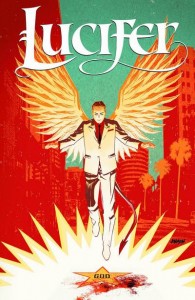 dark secrets and demons; this issue, like the first two, has at least a couple of omg creep-out moments wrapped around a smart, detailed plot, and looks like it’s settling in for a long run. Lucifer is a return for that character; his 75-issue run in the ’00s, by Mike Carey, ended with the Morningstar leaving our universe behind forever — but there’s a TV show coming out, so that trumps closure; Holly Black, the writer, earns points by acknowledging the previous volume instead of trying to sweep it under the rug, and getting her lead character’s urbane, proud and subtly-powerful tone just right.
dark secrets and demons; this issue, like the first two, has at least a couple of omg creep-out moments wrapped around a smart, detailed plot, and looks like it’s settling in for a long run. Lucifer is a return for that character; his 75-issue run in the ’00s, by Mike Carey, ended with the Morningstar leaving our universe behind forever — but there’s a TV show coming out, so that trumps closure; Holly Black, the writer, earns points by acknowledging the previous volume instead of trying to sweep it under the rug, and getting her lead character’s urbane, proud and subtly-powerful tone just right.
 Klaus #2 (of 6) — Writer: Grant Morrison; Art/Colors: Dan Mora
Klaus #2 (of 6) — Writer: Grant Morrison; Art/Colors: Dan Mora
Autumnlands #8 — Writer: Kurt Busiek; Art: Benjamin Dewey; Colors: Jordie Bellaire
Phonogram: The Immaterial Girl #5 (of 6) — Writer: Kieron Gillen; Art: Jamie McKelvie; Colors: Matthew Wilson
 The Wicked and the Divine #17 — Writer: Kieron Gillen; Art/Colors: Brandon Graham
The Wicked and the Divine #17 — Writer: Kieron Gillen; Art/Colors: Brandon Graham
I Hate Fairyland #3 — Writer/Artist: Skottie Young; Colors: Jean-Francois Beaulieu
The indy books for the week: Klaus is Grant Morrison’s Santa origin; naturally, he’s an anti-totalitarian 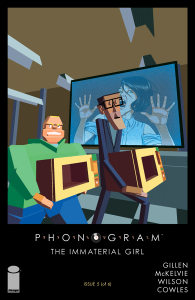 freedom fighter with a knack for making toys, and Morrison gets credit for not making that concept as stupid or fey as any other writer would have made it. Autumnlands got some votes for best series in the year-end lists coming out recently, and it’s easy to see why: it’s a very-well-realized high-fantasy tale of a human brought to an Earth of anthropomorphic animals that’s always been run on magic — except that the magic has been slowly fading away. Great art, great story — and if it looks good, get the first trade collection to really experience it
freedom fighter with a knack for making toys, and Morrison gets credit for not making that concept as stupid or fey as any other writer would have made it. Autumnlands got some votes for best series in the year-end lists coming out recently, and it’s easy to see why: it’s a very-well-realized high-fantasy tale of a human brought to an Earth of anthropomorphic animals that’s always been run on magic — except that the magic has been slowly fading away. Great art, great story — and if it looks good, get the first trade collection to really experience it 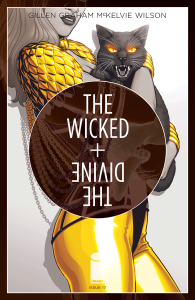 in depth. Kieron Gillen scores twice this week — once with Phonogram: The Immaterial Girl, where he and old collaborator Jamie McKelvie take on a third volume of their series where music is, literally, magical; this series has been fun for watching its heroine navigating, and trying to escape, a world of music videos: check its cover reference to Dire Straits’s “Money For Nothing,” an ’80s MTV staple. Because McKelvie’s been busy with that story, Gillen’s been using guest artists on their other book, The Wicked and the Divine, and in this issue he taps the amazing Brandon Graham (King City, Multiple Warheads and
in depth. Kieron Gillen scores twice this week — once with Phonogram: The Immaterial Girl, where he and old collaborator Jamie McKelvie take on a third volume of their series where music is, literally, magical; this series has been fun for watching its heroine navigating, and trying to escape, a world of music videos: check its cover reference to Dire Straits’s “Money For Nothing,” an ’80s MTV staple. Because McKelvie’s been busy with that story, Gillen’s been using guest artists on their other book, The Wicked and the Divine, and in this issue he taps the amazing Brandon Graham (King City, Multiple Warheads and 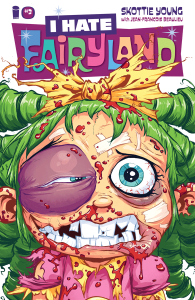 Island) to conclude that book’s second volume; that should really be all the information you need to check it out (that’s his alternate cover for the book gracing the top of this post). Finally, there’s I Hate Fairyland, Skottie Moore’s anti-Wizard of Oz comic, wherein a little girl who’s entered the place and embarked on a quest has failed at it spectacularly, spending thirty years searching for a way out, never aging in her body but getting more and more insane (and murderous) in her mind: it’s over-the-top ultra-violence all rendered in Young’s bright, cartoony style, and if you’re in the right mood it’s a hoot and a half, and a good palette-cleanser to end the week.
Island) to conclude that book’s second volume; that should really be all the information you need to check it out (that’s his alternate cover for the book gracing the top of this post). Finally, there’s I Hate Fairyland, Skottie Moore’s anti-Wizard of Oz comic, wherein a little girl who’s entered the place and embarked on a quest has failed at it spectacularly, spending thirty years searching for a way out, never aging in her body but getting more and more insane (and murderous) in her mind: it’s over-the-top ultra-violence all rendered in Young’s bright, cartoony style, and if you’re in the right mood it’s a hoot and a half, and a good palette-cleanser to end the week.



